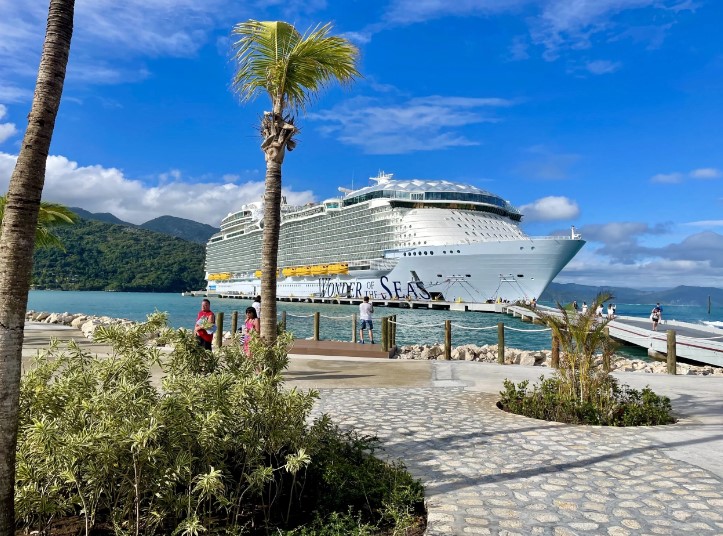“Massive seaweed blob invades Florida beaches!”
“Huge, smelly snake of seaweed headed toward the Caribbean!”
Though the headlines sound like something out of a 1950s horror movie, sargassum is reaching record levels this year, with some beaches already seeing large amounts of the brown seaweed washing ashore.
Does sargassum have the potential to sour your seaside vacation in the coming months? TPG spoke with oceanography experts to find out.
What is sargassum?
Sargassum is a large, brown seaweed – the common name for various species of marine plants and algae – that floats along the ocean’s surface.
In healthy amounts, sargassum is a critical habitat for sea creatures. Animals like small fish, crabs, mollusks and even young sea turtles hang out around patches of sargassum for shelter and because the smaller residents provide a food resource for the larger ones.
Sargassum is neither destructive nor harmful under normal circumstances, even when left unattended on beaches. When it accumulates in massive amounts like it is this year, however, it can have a negative impact on the ecosystem and local economies.
Why is this year’s sargassum bloom concerning?
Based on satellite imagery from a quarterly bulletin provided by the Centre for Resource Management and Environmental Studies at the University of the West Indies in Barbados, there is more than 200{0b5b04b8d3ad800b67772b3dcc20e35ebfd293e6e83c1a657928cfb52b561f97} more sargassum visible in the Atlantic Ocean than there was at this time last year.
This “blob” is more technically referred to as the Great Atlantic Sargassum Belt, a mass of sargassum. Despite what satellite images show, however, it isn’t one continuous blob.
Sign up for our daily newsletter
“There is good evidence based on the satellite imagery that this will be a big year,” Sea Education Association Professor of Oceanography Jeffrey M. Schell told TPG.
Some patches can be miles long and tens of meters wide, while others can be more scattered and dispersed, but together, they cover an area “several hundred miles wide across the Atlantic,” according to Schell.
When sargassum is as thick and plentiful as it is this year, it can cause major trouble both at sea and on the beach.
Think of it as “too much of a good thing,” explained Yuyuan Xie, an oceanographer in the Optical Oceanography Laboratory at the University of South Florida.
Xie, whose laboratory works with the Satellite-based Sargassum Watch System, told TPG, “Large mats of sargassum in the ocean can block sunlight [necessary for coral and sea grasses], tangle boat propellers and block boat ways, among other things.”
“On beaches, large amounts of rotten seaweed are harmful to animals and humans because they attract insects, harbor bacteria and smell quite bad as it decomposes,” Xie added.
Should you cancel your upcoming beach vacation?
Northern islands of the Lesser Antilles are already seeing the negative effects of sargassum play out. Projections show that southern islands like Grenada, the Grenadines, Barbados and Trinidad and Tobago, as well as beaches in Mexico, the Florida Keys and Florida’s east coast, are expected to be affected in the coming months.
Related: 9 new Caribbean resorts, from Barbados to Belize, you need to visit
The sheer number of beaches affected may be cause for concern. However, there are a few reasons why the experts who spoke with TPG say “not so fast” when it comes to canceling your summer beach vacation.
First and foremost, not every beach in a given area will be affected by this pernicious seaweed.
“We are still refining our projection methods to better predict where sargassum will end up each year, but we do understand that windward sides of islands are more exposed,” Schell said.
Winds, currents and tides help determine where exactly sargassum will accumulate and wash ashore. And, as they say, “The tides, they are a-changin’.”
“It’s difficult to predict exactly which beaches will receive more sargassum than others because all of these play a role in sargassum beaching in a local region,” Xie explained.
“Even an island like Anguilla that is already seeing sargassum this year is only seeing it on the windward side of the island. The beaches on the leeward side are probably still great beaches to visit,” he added.
Affected beach destinations also have cleanup initiatives to help keep their beaches looking beautiful and inviting to visitors. “The local management agencies typically remove large amounts of seaweed from the beach before it decomposes,” Xie said.
It may be difficult to determine exactly which beaches will be affected and when, but an entire city or beach community should not be inundated with sargassum to the point that you can’t enjoy some fun in the sun. Be prepared to visit a variety of nearby beaches and plan a few alternate activities, like visiting an aquarium or botanical garden, as a backup plan.
What causes massive sargassum blooms?
Because sargassum undergoes seasonal growth cycles, some years are worse than others, and researchers are still trying to fully understand these cycles. One thing they have observed is that the problem is getting worse over time.
“With climate change and global warming, we’ve noticed the low years aren’t getting as low as they used to, and the high years are getting higher,” Schell said.
Their ability to track sargassum is getting better every year. Schell’s team has already made one incredible breakthrough that could change how sargassum levels are predicted in the future.
“We’ve found that there are actually three distinct morphotypes found in drifting sargassum blooms,” shared Schell.
Whether one, two or all three morphotypes are prolific in a certain year can be determined without even looking at satellite images by monitoring water temperatures and nutrient characteristics.
Schell’s team conducts research in the field and in the lab at Eckerd College in St. Petersburg, Florida, to understand sargassum growth rates under different temperatures, salinity and nutrient conditions.
Schell — along with his colleagues Dr. Amy Siuda and Dr. Deborah Goodwin — theorizes that sargassum is more likely to have a big year when climate conditions are favorable for all three morphotypes to thrive.
“We think the blooms are getting larger and larger over time, when conditions are just right, for all three forms of drifting sargassum to bloom,” he explained.
What can be done to mitigate the problem?
Experts are looking into a number of methods for collecting and cleaning up sargassum before it becomes a headache for beach communities and beachgoers.
“We’ve yet to find a silver bullet,” Schell said, “but sargassum can be collected at sea or on the beach. It is a habitat, though, so we have to be mindful and respectful of the animals who call sargassum home.”
The majority of current cleanup efforts focus on removing sargassum from the beach after it washes ashore using implements as simple as rakes and wheelbarrows to more futuristic methods like beach-cleaning robots.
The issue then becomes what to do with it. Fort Lauderdale has instituted a seaweed composting program that transforms seaweed into soil that can be used for city planting projects, saving the city tens of thousands of dollars annually.
The Rum & Sargassum program in St. James, Barbados, is creating an inexpensive, alternative fuel source for vehicles using locally sourced waste products like rum distillery wastewater, sheep manure and sargassum.
According to Schell, these innovations (and those that are still being developed) are a boon to cleanup efforts and the bottom line.
“The money involved in cleanup and the impact on local fishing activity and tourism has a tremendous economic impact on beach communities,” he said. “Any economic return found by creating a product it can be turned into can make a big difference.”
Bottom line
Shook up about sargassum? Don’t be.
Levels are on the rise, and this year, in particular, is already seeing large amounts of sargassum washing ashore. However, beach communities are well practiced in cleaning up seaweed, and researchers like Schell and Xie are hard at work understanding sargassum and how to minimize the problems it can cause.
Related reading:





More Stories
17 Most Beautiful Beaches in the World
Could Mission Beach vacation rental hosts lose licenses for not being truthful on applications?
Enjoy The Quintessential Palm Beach Vacation At The Four Seasons Palm Beach